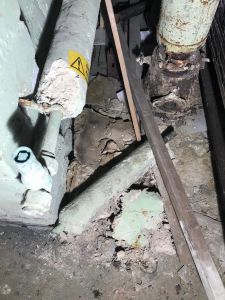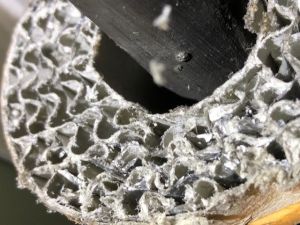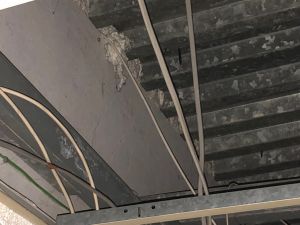What does asbestos insulation look like?
Last Updated on 4 July 2023
What is asbestos insulation?
Are you wondering what asbestos insulation is and what does it look like?
Before we get onto answering the question of ‘what does asbestos insulation look like?’, let’s firstly explain what it is.
Asbestos is a naturally occurring material that was widely utilised in building and industry before the health dangers were generally known. Its fibres are strong, flexible, and resistant to heat and fire, making them excellent for use in insulation goods.
Asbestos insulation is one group of asbestos containing materials or ACM’s. Furthermore, It’s a form of thermal insulation material that incorporates asbestos fibres.
The number of ACM’s within the built environment is generally thought to be around 4000. There is no firm documentary evidence, but anecdotally, those in the professional industries see this as a fair estimation.
In summary, there are literally hundreds of different types of asbestos insulation that were manufactured over decades within the UK and they all look different.
To demonstrate, asbestos insulation comes in a variety of forms, including loose-fill insulation, spray-on insulation, pipe insulation, and vermiculite insulation.
It was most commonly used in buildings, ships, and industrial environments to offer thermal insulation and fire protection.
When asbestos fibres are disturbed, such as during installation or removal, they become airborne and easily inhaled, potentially leading to major health concerns such as lung cancer, mesothelioma, and asbestosis.
As a result, the use of asbestos insulation has been prohibited or highly restricted in many countries across the world, and measures must be taken during the removal and disposal of any asbestos-containing products to avoid exposure.
What does asbestos insulation look like?
So what exactly does an asbestos insulation material look like?
Depending on the use and the type of asbestos utilised, asbestos insulation can take several forms. So here’s a list of some of the most popular forms of asbestos insulation and what they look like:-
-
Loose-fill insulation:
This is comprised of asbestos fibres that are blown or poured into an enclosed space, such as an attic or wall cavity.
-
Pipe insulation:
Asbestos was commonly used to cover pipes and boilers in industrial settings. What does this form of asbestos insulation look like? The insulation was often made of a firm, white or grey substance that resembled plaster or cement and was wrapped in a protective material such as cloth or metal.
-
Vermiculite insulation:
Some older homes and structures may have vermiculite insulation, which was frequently contaminated with asbestos. What does this form of asbestos insulation look like? Vermiculite insulation is little grayish-brown pellets or granules that can be found in attics or wall cavities.
-
Sprayed-on insulation:
Asbestos was occasionally used as a sprayed-on insulation material, notably in industrial contexts. What does this form of asbestos insulation look like? The insulation appears as a thick, fibrous material that sticks to surfaces and may be covered with a protective coating.
Insulation that contains asbestos materials comes in the form of textiles (photo 1 woven textile cover to HVAC ductwork). It can be in the form of a board such as asbestos insulation board AIB used to protect steel beams (see photo 2).
Also, It can be a sprayed raw fibre used as fire protection (photo 3). And It can be a hand applied thermal pipe insulation (4th photo). It can also come in paper/cardboard form known as ‘Aircell’ (photo 5). Additionally, It can even be put into gaps in raw form as a firebreak (see photo 6 for what this type of asbestos insulation may look like).
Hopefully, the photos below will help to distinguish what an asbestos insulation material can look like in situ.
- Photo 1 – asbestos woven textile cover to HVAC ductwork
- Photo 2 – asbestos insulation board AIB used to protect steel beams
- Photo 3 – sprayed raw fibre asbestos used as fire protection
- Photo 4 – hand applied asbestos thermal pipe insulation
- Photo 5 – paper/cardboard aircell asbestos insulation
- Photo 6 – asbestos used in raw form as a firebreak
It is crucial to note that asbestos insulation may not always be apparent to the human eye since it may be coated in other materials, making it look like something else, or it may be buried behind walls or ceilings.
Therefore, If you believe that your house or business has asbestos insulation, you should contact a professional asbestos surveying firm such as ours.
UK was a huge asbestos manufacturer
The UK was historically one of the largest manufacturing bases in the world in relation to asbestos products.
Asbestos mining began in the UK in the late 19th century, and by the mid-20th century, the country was one of the largest producers and consumers of asbestos in the world.
Undoubtedly, the real epicentre of this was the North West of England, along what we now refer to as the M62 corridor from Liverpool in the west to Hull in the East.
The large cities of Liverpool, Manchester and Leeds all had huge factories employing 10’s of thousands of employees who made these products. In fact, the largest textile asbestos weaving factory in the world was in Rochdale, Lancashire.
However, in the 1970s and 1980s, the hazardous health effects of asbestos exposure were more generally understood, and the usage of asbestos in the UK began to drop.
Consequently, asbestos usage became illegal in the United Kingdom in 1999, along with its manufacturing and importation.
Despite the banning of asbestos, many older buildings in the UK still contain asbestos-containing materials, and the danger of exposure remains a worry.
The UK government has created rules and regulations for the safe handling and removal of asbestos, and there are a number of asbestos removal businesses that specialise in the safe removal of the material from buildings and other structures.
Why was asbestos used as an insulation material?
Asbestos fibres are naturally occurring materials that are highly resistant to heat and fire, making them a popular choice for insulation in industrial and commercial situations where high temperatures are typical.
Asbestos insulation was often used to retain heat on pipes for example, or protect materials from fire, such as steel structures. (see above photos showing what each of these asbestos insulation materials can look like in situ).
The reason asbestos is so good at thermal insulation and fire protection is due to the way it was formed.
Asbestos is a mineral formed under volcanic levels of heat which then crystalises into mineral veins within rocks as it cools. Because asbestos is created at such high temperatures, when used in conjunction with other applications, it can withstand temperatures that most modern building products cannot.
Furthermore, asbestos was used as insulation since it is very cheap and abundant. It was frequently implemented in building construction, shipbuilding, and other sectors that required insulation.
Unfortunately, it was subsequently revealed that asbestos fibre exposure can cause major health problems such as lung cancer, mesothelioma, and asbestosis.
As a result, the use of asbestos in insulation and other goods has been prohibited or highly restricted in many countries across the world.
Where is asbestos insulation likely to be found?
Asbestos insulation may be found in a number of places, particularly in older buildings and structures built before the 1980s, when the usage of asbestos began to diminish.
When talking about asbestos insulation and what it can look like, we tend to think of a material that is put onto pipes or around boilers, which is true. However, asbestos also became an insulation for industrial machinery, ovens or anywhere we needed to retain heat or prevent heat affecting a material.
There are even more of these products. Asbestos insulation Board (AIB) was used to protect steel structures from fire (see above photo showing what this type of asbestos insulation material can look like in situ).
Sprayed raw asbestos was coated to ceilings to prevent fire damage. Asbestos gloves were used to protect the hands of employees handling anything that would burn the skin.
As the use of asbestos changed and certain types of asbestos were banned or phased out, the types of asbestos insulation also changed. In particular, we started manufacturing asbestos papers and textiles and using those to do the same job. There are also products which are part asbestos and part fibreglass (none asbestos) which were used as pipe insulation.
There are asbestos paper and cardboard products which were used to insulate pipes and boilers which we still find in commercial as well as residential properties.
To conclude, now that you know what asbestos insulation can look like, here are all the common areas it can be found in:-
-
Attics and wall cavities:
Asbestos-containing insulation was extensively utilised to offer thermal insulation and noise control in attics and wall cavities.
-
Pipe Insulation:
Asbestos was frequently used to insulate pipes, boilers, and other types of heating equipment. In fact, wrapping the insulation around the pipes or boilers and securing it with wire or tape was customary.
-
Heating & Air Conditioning:
HVAC systems, including ducting, air handlers, and filters, may include asbestos-containing materials.
-
Electrical Insulation:
Asbestos was also used as an electrical insulator in a range of applications, including switchboards, electrical panels, and wiring insulation.
-
Roofing materials:
Asbestos was frequently used in roofing materials such as shingles, tiles, and felt.
Build dates are important when identifying asbestos
When talking about asbestos insulation, it is important to use the context of build dates. These can often reflect the historical change in the use of asbestos containing materials.
It is important that when buying, selling, leasing or working in or on buildings, that we recognise the complex nature of asbestos manufacture and use.
It is dangerous to assume something will or won’t be present based on limited knowledge. Always consult an asbestos professional surveyor who is independent of asbestos removal companies.
So be sure to obtain asbestos information and ensure an appropriate asbestos survey and management plan are in place. This ensures compliance and protects those working in or on a building from asbestos.
Advice on asbestos
We hope our article ‘what does asbestos insulation look like?’ has been helpful in identifying potential asbestos materials. Meanwhile, for any more advice on asbestos insulation or asbestos in general, then please contact us on 0800 141 2676, email us at info@rbasbestos.co.uk or fill in the form below.







